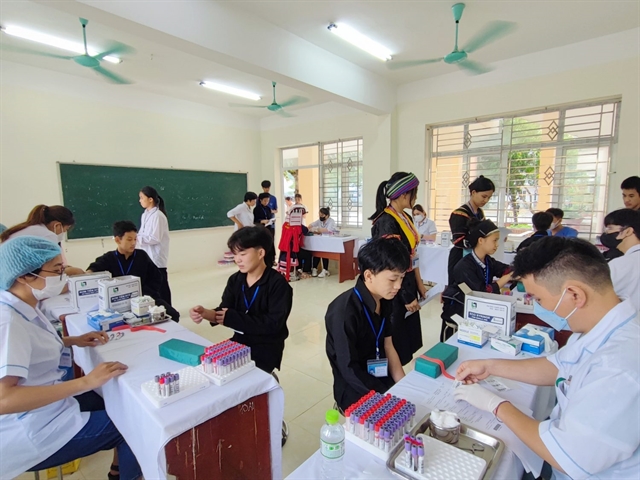 Society
Society

 |
| Students of the Boarding High School for Ethnic Minorities in Hà Giang Province participate in blood tests screening for congenital thalassemia genes. — Photo suckhoedoisong.vn |
HÀ NỘI — More than 8,000 children are born with thalassemia disease in Việt Nam every year, including approximately 2,000 with severe conditions, Dr Nguyễn Thị Thu Hà, director of the Thalassemia Centre under the Central Institute of Haematology and Blood Transfusion, has said.
Notably, the risk of having severely affected children is higher in northern mountainous provinces such as Hòa Bình, Sơn La, Bắc Kạn and Tuyên Quang, and among ethnic minorities such as the Mường, Thái, Tày, Nùng and Dao.
Hà revealed the case numbers of the congenital blood disorder in Việt Nam during a training conference to enhance awareness of congenital thalassemia for health workers at hospitals and health centres in northern Hà Giang Province.
Dr Vũ Đức Bình, deputy director of the Central Institute of Haematology and Blood Transfusion, said that congenital thalassemia is the most common genetic disorder globally, affecting an estimated 7 per cent of the world's population. The disease has caused serious consequences for population quality and lineage, imposing a significant burden on families and society.
In 2017, the institute conducted an epidemiological and genetic study of congenital thalassemia nationwide. The results showed that carriers of the disease gene were present in all ethnic groups, in all localities, with an estimated 14 million people carrying the gene for congenital thalassemia.
The prevalence of the disease gene among the Mông ethnic group was 6.72 per cent, the Tày ethnic group was 26.11 per cent, and the Dao ethnic group was 25.46 per cent.
From November 7-10, the institute collaborated with the Department of Health, the Department of Education and Training, and boarding schools for ethnic minorities in northern Hà Giang Province to conduct blood tests screening 1,300 students for congenital thalassemia.
Disease prevention activities included training on diagnosis, treatment and prevention of congenital thalassemia for healthcare professionals; communication and dissemination of knowledge about congenital thalassemia for educators; and blood tests screening nearly 1,400 participants for congenital thalassemia, including healthcare professionals and educators participating in training, as well as students in boarding schools.
This is part of the project to improve the health and nutrition status of ethnic minorities, and prevent malnutrition in children under the National Target Programme for Socio-Economic Development in Ethnic Minority and Mountainous Areas for the 2021-30 period. The programme was approved by the Prime Minister on October 14, 2021.
In the first phase of 2021-2025, thalassemia prevention and control activities are carried out in five provinces of Hà Giang, Yên Bái, Bắc Giang, Thanh Hóa and Nghệ An. The targets include reducing the number of thalassemia carriers, reducing the number of newborns with the disease, gradually improving the quality of treatment at healthcare facilities for ethnic minorities, and gradually extending the life expectancy of current patients.
Dr Đỗ Thị Mỹ, deputy director of Hà Giang Province’s Department of Health, stated that with a population of 935,700 people, including 19 ethnic groups, of which over 87 per cent are ethnic minorities, the implementation of thalassemia prevention in Hà Giang Province is crucial for the healthcare of the local population.
Mỹ said the programme would contribute to improving the quality of life and stature of ethnic minorities, reducing costs for medical examinations and treatment. Initially, the programme has received the involvement of healthcare units at all levels since 2022.
Phạm Thị Hà, deputy principal of the Boarding High School for Ethnic Minorities in Hà Giang Province, said this is a meaningful opportunity for students as they are approaching adulthood, gaining awareness before marriage for disease prevention and spreading information to their families and communities.
“Teachers will also acquire additional knowledge to educate students and prevent diseases within the community," she said.
Hà said that many had some anxiety about being tested for the first time, but were then enthusiastic after receiving encouragement and explanations from teachers and healthcare staff.
Currently, the school has 527 students representing all 19 ethnic groups in the province.
Hà, director of the Thalassemia Centre, emphasised the overarching goals of the congenital thalassemia prevention and control programme, which are to improve the quality of the population and enhance the quality of life for patients.
To achieve the goal of gradually reducing and ending the births of children with the disease or carrying the disease gene, Hà suggested some solutions, including screening to identify thalassemia carriers among high school students, encouraging thalassemia screening for couples before marriage, especially in high-risk areas, and giving screening and thalassemia counselling for pregnant women in the first three months of pregnancy.
She also stressed the need for clinics and thalassemia counselling in all obstetrics departments of district-level hospitals, combining health examinations with thalassemia counselling for young workers, students and university students. — VNS




